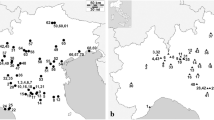Abstract.
A sacred area was discovered in the centre of Mainz, the capital Mogontiacum of the Roman province of Upper Germany, Germania Superior. Recent epigraphical evidence led to the discovery that the temple had been dedicated to the goddesses of Isis and Magna Mater. Sediments rich in archaeobotanical remains were recovered from more than 100 sacrificial pits for the burning of offerings, 15 large round sacrificial areas with stone walls, two favessae (coffers), several deposits under tiles on the floor, others on the floor itself, censers and other bowls, a well and a latrine. The first results focus on the most conspicuous plant offerings, for instance considerable numbers of pine nuts and pine cones, figs and dates. The aim is to establish an overview of the principal plants used as offerings and to determine the characteristic features of typical offerings to Isis and Magna Mater. It was not expected that the assemblages would be so similar, regardless of which site was analysed. Since no other sacred area from the Roman period has been as intensively investigated archaeobotanically, the results are compared with others from the literature.
Similar content being viewed by others
Author information
Authors and Affiliations
Additional information
Received October 23, 2001 / Accepted May 7, 2002
Rights and permissions
About this article
Cite this article
Zach, B. Vegetable offerings on the Roman sacrificial site in Mainz, Germany – short report on the first results. Veget Hist Archaeobot 11, 101–106 (2002). https://doi.org/10.1007/s003340200011
Published:
Issue Date:
DOI: https://doi.org/10.1007/s003340200011




